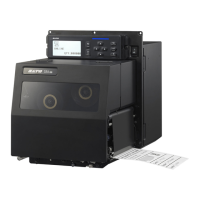207
Symbol size table
*Please use the following capacity listed in the table above.
If you use more than the upper limit of each symbol size, it may result in the command error.
4. Aztec code is settable in the range of (00H - FFH). For binary data, the user needs to set the number of data correctly by using
<ESC>DN command. The symbol cannot be printed if the number of data and print data do not match.
5. Specify [1BH, 1BH] when printing 1BH. In the case, the number of data is [0002].
6. Use a pair of [1BH,*] in the input data when using Extended Channel Interpretation (ECI). '*' specifies a value between 31H to
36H. The numbers in the below FLG(1) to FLG(6) are the number of digits used for ECI.
<ESC>1 -> FLG(1) ECI data to be specified is 1 digit
<ESC>2 -> FLG(2) ECI data to be specified is 2 digit
<ESC>3 -> FLG(3) ECI data to be specified is 3 digit
<ESC>4 -> FLG(4) ECI data to be specified is 4 digit
<ESC>5 -> FLG(5) ECI data to be specified is 5 digit
<ESC>6 -> FLG(6) ECI data to be specified is 6 digit
Example) Data in case of <ESC>4: <ESC>41111ABCDE
Scan data in case of <ESC>4: \001111ABCDE ('\' depends on the setting of the scanner, and it may be different.)
(1) <ESC>4 becomes FLG(4), and trailing [1111 (4 digits)] is treated as ECI data.
(2) The leading is padded with '0' because the number of digit is not enough (2 digits), and it will be [\001111].
7. Message ID is enabled only when the number of symbols at structured append mode is auto, or structured append block
number is specified, and symbols are printed separately as a result.

